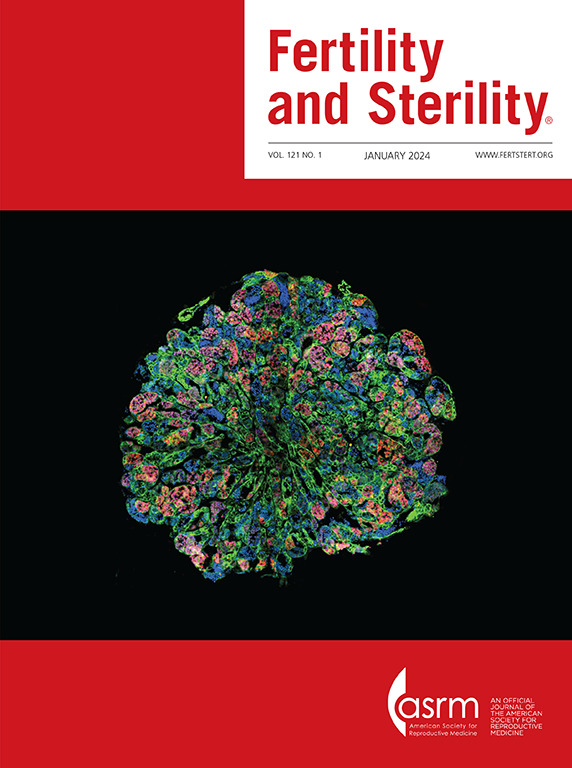维生素D结合蛋白与生殖结果。
IF 7
1区 医学
Q1 OBSTETRICS & GYNECOLOGY
引用次数: 0
摘要
目的:目前尚不清楚D结合蛋白(DBP)是否在生殖结局中起作用。现有的少数研究在很大程度上假设DBP的任何影响都是由于其根据“游离激素理论”调节维生素D的生物利用度,尽管它具有许多与维生素D无关的功能。因此,本研究旨在全面评估DBP浓度/单倍型与多囊卵巢综合征(PCOS)或不明原因不孕症患者接受卵巢刺激的生殖结局之间的关系。设计:回顾性队列研究,随机对照试验的二次分析:多囊卵巢综合征(PPCOS II)妊娠和卵巢刺激(AMIGOS)多胎宫内妊娠的评估。受试者:376名PCOS (PPCOS II)患者,505名不明原因不孕(AMIGOS)患者。干预或暴露dbp浓度;Gc1f, Gc1s, Gc2单倍型。主要观察指标:活产。继发性:早孕流产;早产,先兆子痫和胎儿生长受限的组合。结果共纳入881名受试者。舒张压浓度、gc1或Gc2与活产之间没有关联。当调整年龄、种族、BMI、25(OH)D浓度和治疗组时,Gc1f单倍型与活产几率增加(调整优势比[aOR] 1.49, 95% CI 1.06-2.09, p=0.02)和早期妊娠丢失几率降低(aOR 0.46, 95% CI 0.25-0.86, p=0.02)相关。与产科并发症无相关性(aOR 0.76, 95% CI 0.39-1.47, p=0.42)。结论舒张压Gc1f单倍型与25(OH)D和舒张压浓度无关,可增加活产率和降低妊娠早期流产率。由于Gc1f导致DBP变体与维生素D的结合亲和力最大,这些发现挑战了目前DBP与生殖结果之间的关联主要是由于维生素D生物利用度的调节的说法。需要进一步的研究来调查DBP在生殖结果中的作用的其他机制。本文章由计算机程序翻译,如有差异,请以英文原文为准。
Vitamin D Binding Protein and Reproductive Outcomes.
OBJECTIVE
Little is known about whether D binding protein (DBP) plays a role in reproductive outcomes. The few existing studies have largely presumed that any effects of DBP are due to its modulation of vitamin D bioavailability per the "free hormone theory" despite its many vitamin D-independent functions. This study therefore aimed to comprehensively evaluate the association between DBP concentration/haplotype and reproductive outcomes in patients with polycystic ovary syndrome (PCOS) or unexplained infertility undergoing ovarian stimulation.
DESIGN
Retrospective cohort study, secondary analysis of randomized controlled trials Pregnancy in Polycystic Ovary Syndrome II (PPCOS II) and Assessment of Multiple Intrauterine Gestations from Ovarian Stimulation (AMIGOS).
SUBJECTS
376 participants with PCOS (PPCOS II), 505 participants with unexplained infertility (AMIGOS).
INTERVENTION OR EXPOSURE
DBP concentration; DBP Gc1f, Gc1s, Gc2 haplotypes.
MAIN OUTCOME MEASURES
Primary: live birth. Secondary: early pregnancy loss; composite of preterm delivery, preeclampsia, and fetal growth restriction.
RESULTS
881 participants were included. There was no association between DBP concentration, Gc1s, or Gc2 and live birth. When adjusting for age, race, BMI, 25(OH)D concentration, and treatment arm, the Gc1f haplotype was associated with increased odds of live birth (adjusted odds ratio [aOR] 1.49, 95% CI 1.06-2.09, p=0.02) and decreased odds of early pregnancy loss (aOR 0.46, 95% CI 0.25-0.86, p=0.02). There was no association with obstetric complications (aOR 0.76, 95% CI 0.39-1.47, p=0.42).
CONCLUSIONS
The Gc1f haplotype of DBP was associated with increased odds of live birth and decreased odds of early pregnancy loss independent of 25(OH)D and DBP concentration. As Gc1f results in the DBP variant with the greatest binding affinity for vitamin D, these findings challenge the current narrative that associations between DBP and reproductive outcomes are primarily due to modulation of vitamin D bioavailability. Additional studies are needed to investigate other mechanisms for the role of DBP in reproductive outcomes.
求助全文
通过发布文献求助,成功后即可免费获取论文全文。
去求助
来源期刊

Fertility and sterility
医学-妇产科学
CiteScore
11.30
自引率
6.00%
发文量
1446
审稿时长
31 days
期刊介绍:
Fertility and Sterility® is an international journal for obstetricians, gynecologists, reproductive endocrinologists, urologists, basic scientists and others who treat and investigate problems of infertility and human reproductive disorders. The journal publishes juried original scientific articles in clinical and laboratory research relevant to reproductive endocrinology, urology, andrology, physiology, immunology, genetics, contraception, and menopause. Fertility and Sterility® encourages and supports meaningful basic and clinical research, and facilitates and promotes excellence in professional education, in the field of reproductive medicine.
 求助内容:
求助内容: 应助结果提醒方式:
应助结果提醒方式:


